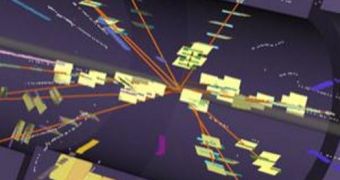This Monday marked an historic event. After one year in repairs, the Large Hadron Collider (LHC), the largest particle accelerator in the world, has finally began colliding beams of protons together, in its quest for the elusive Higgs boson. This is the elementary particle that, if found, will finally confirm the Standard Model, the only approach to explaining basic interactions that has been developed in elementary physics for the past decades. If the Higgs is not found, then experts will need to start from scratch, NewScientist reports.
The European Organization for Nuclear Research (CERN), which manages the 27-kilometer-long tunnels of the LHC, together with the instrument, detectors, and related facilities, was supposed to start operating the accelerator in September 2008, but a catastrophic failure prevented that from happening. A large leak of supercold helium overwhelmed a portion of the tunnels, causing 14 months of delays, and a rewiring of the entire affected portion. The superconducting magnets that were basically ripped out of their footings were also replaced and anchored back, and now everything is running smoothly.
The first collision at the LHC “is great news, the start of a fantastic era of physics – and hopefully discoveries – after 20 years' work by the international community to build a machine and detectors of unprecedented complexity and performance,” says ATLAS detector project spokesperson Fabiola Gianotti. The ATLAS is one of three massive particle detectors on the accelerator, whose sole job is to analyze the elements that result when protons beams collide inside its massive, 360-degree camera. It is one of two detectors that will discover the Higgs, if it's there.
The instrument was also the host of the first collisions, which took place on Monday at 1322 GMT. The beams of protons that slammed into each other were traveling at almost the speed of light. Additional collisions then took place in the CMS and LHCb detectors, other instruments also designed to search through the massive amount of particles that are generated when the protons split. Each of the beams had an energy of 450 GeV, for a combined effect of 900 billion electron volts. But the maximum operating power of the accelerator is 7 TeV per beam, a combined power of 14,000 GeV (14 TeV).
Over the coming months, the energy of the proton beams will be gradually increased, with a 3.5 TeV per beam of energy scheduled to be achieved at the beginning of next year. According to CERN, by 2011, plans are to run the LHC at full capacity and start looking for the Higgs boson thoroughly.

 14 DAY TRIAL //
14 DAY TRIAL //